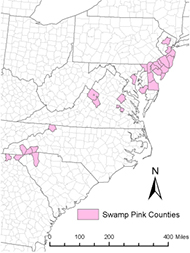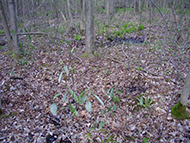According to the U.S. Fish and Wildlife Service (FWS), the swamp pink has been recorded within four counties in Virginia1 and three counties in Maryland2. The majority of known colonies of swamp pink actually occur in Delaware and New Jersey, so it is possible that there could be more locations throughout Virginia and Maryland where this species occurs.
 |
| Swamp Pink has been recorded in Augusta, Nelson, Caroline and Henrico counties in Virginia |
The FWS generally recommends that surveys be conducted on any site within a county of known swamp pink occurrence if suitable habitat is present, or in adjacent counties if predictive models indicate that habitat could be present.
Preliminary (and relatively inexpensive) site evaluations to determine whether potentially suitable habitat is present may be conducted any time of the year; and for some sites, a habitat evaluation may be all that is necessary to confirm absence of the species. However, because of flowering time, and fall and winter leaf-cover, surveys for this species in suitable habitat areas should be conducted between April 15 and May 31 (optimal time, when in flower) or June 1 and September 30 (when basal leaves are present) according to FWS guidelines.
Due to this limited survey "window," proper planning for sites having suitable habitat is critical. Failure to have a swamp pink survey conducted during the appropriate season could potentially result in wetlands permitting delays! Therefore, project managers of sites within the species' range that will require wetlands permitting should also consider having a swamp pink habitat evaluation (or survey) conducted as early in the development process as possible, preferably in the April 15 to May 31 time frame, to minimize potential impacts to your development schedule. It should also be noted that surveys are valid for a period of five years, and if the site is not developed within five years of the completion of the survey, the FWS may request that the site be re-surveyed.
Plant Habitat and Characteristics
 |
| Typical Swamp Pink habitat |
Swamp pinks generally occur in forested wetlands with canopy cover between 20 and 100 percent. The swamp pink requires water year-round, so a shallow, regular and stable groundwater table is the limiting factor in providing suitable habitat. Plants often found with the swamp pink include sweetbay magnolia (Magnolia virginiana), sphagnum mosses (Sphagnum spp.), cinnamon fern (Osmunda cinnamomea), skunk cabbage (Symplocarpus foetidus), and laurels (Kalmia spp.). Swamp pink is often found growing on the hummocks formed by trees, shrubs, and sphagnum mosses.
Swamp pink has dark green leaves that form an evergreen basal rosette. In spring, some plants will produce a flowering stalk up to 3 feet tall that is topped by a 1 to 3-inch-long cluster of 30 to 50 small, fragrant, pink flowers. The evergreen leaves of swamp pink can be seen year round, and flowering occurs from April to May.
Conducting an ETS Survey
In order to rely on a swamp pink survey, the FWS maintains a list of consultants and botanists with sufficient experience conducting swamp pink surveys to reliably survey a site for this species. WSSI has conducted a number of habitat evaluations and surveys for the swamp pink and has staff included on the FWS list of approved swamp pink surveyors.
For further information about this topic or to have WSSI conduct a swamp pink habitat evaluation or survey on your site, please contact Mark Headly, Ben Rosner or Mike Klebasko.
|